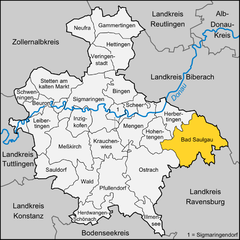Bad_Saulgau
Bad Saulgau
Town in Baden-Württemberg, Germany
Bad Saulgau is a town in the district of Sigmaringen, in Baden-Württemberg, Germany. It is situated 23 km east of Sigmaringen, and 27 km north of Ravensburg between the Danube and Lake Constance.
You can help expand this article with text translated from the corresponding article in German. (February 2009) Click [show] for important translation instructions.
|




